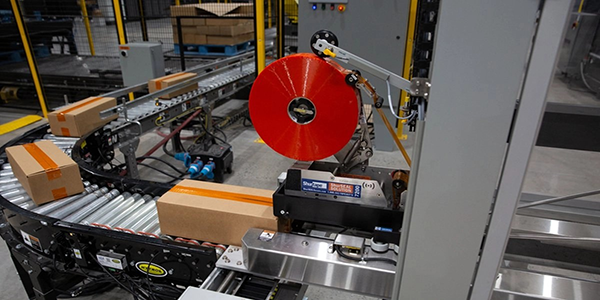From innovations in primary packaging design to efficient solutions for secondary packaging, the packaging industry always has its eye on improvement. Out of all the issues that influence evolution and innovation in packaging, three continually rise to the top of any conversation on its future: sustainability, automation and the rise of e-commerce.
Let’s take a look at the role that end-of-the-line case sealing solutions play in addressing these hot topics.
Sustainability
People often forget that the first step on the path to creating less waste is consuming fewer resources, or source reduction. This is as true on the packaging line as anywhere else in production.
Light-weighting is the subject of heated debate throughout the packaging industry. While reducing packaging weight can be a form of source reduction as well as a strategy for reducing the carbon footprint attached to shipping, there are examples of light-weighting going too far: containers that are perceived as flimsy by the consumer as well as those that replace heavier reusable materials with lighter ones that are 100% waste. Like any other strategy, light-weighting must take performance into account.
While the first impulse might be to use the heaviest gauge tape in the widest width, the reality is that with the right tape application technology you can achieve super performance for secondary packaging with a thinner, narrower tape.
Rightsizing secondary packaging is essential to reducing waste, shrinking the carbon footprint and also reducing the cost of transportation and warehousing. Rightsizing the tape to the application for the best performing seal adds to those costs, carbon footprint and waste reductions. For example, if you shorten the tab by one inch without compromising the seal strength, that’s four inches of tape saved on every single box coming off the line.
Like light-weighting, effective rightsizing starts with getting experts in secondary packaging onto the floor to perform a continuous improvement evaluation.
Automation
There is little question that the future of secondary packaging is automated. While the adoption curve remains steep, those who have embraced the technology now focus on operating it at the highest levels of efficiency in order to maximize their investment.
Maximizing overall equipment effectiveness (OEE) is the name of the game, no matter what parts of the manufacturing and/or packaging processes have been automated.
Automated processes and the pursuit of maximum OEE put pressure on material performance, as any weaknesses will result in downtime on the line. Catastrophic failures aren’t the issue – those get addressed immediately. It’s the microstops of a minute here, 30 seconds there that reduce OEE: tape breakage, unsealed cartons and changing out tape rolls are all familiar culprits.
And while it may be only five minutes out of a shift, when you apply that to three shifts a day across a dozen lines every shift, microstops become major problems.
Partners versus vendors
Another trend in automation is the relationship between the manufacturers and the suppliers of the technology – especially in end-of-line packaging. Manufacturers are focused on their production and it’s harder for them to acquire capital for those kinds of expenditures, and harder to find maintenance time for that equipment.
The result is more of a partnership relationship with the technology creators rather than an old-fashioned buyer/seller model. They often come in and retrofit the packing lines holistically with no capital outlay required, providing training and online support as well as maintenance services on the equipment, taking the pressure off the manufacturer’s internal team. The only cost for the manufacturer is the consumables.
Meeting the needs of e-commerce
At the beginning of 2020, no one would have argued that e-commerce was the way of the future. As Millennials reach their prime buying years and voice demand technology continues to grow, brick-and-mortar retailers were already struggling to get people in the door.
Then, in March, COVID-19 hit the US, ‘social distancing’ entered our vocabulary, and ordering online went from simply being a convenient option to a safer option – and, in some cases, the only option.
The secondary packaging requirements of e-commerce are entirely different from traditional manufacturing. It’s no longer about packing up a palletized load of identical product to survive the journey from factory to warehouse to retailer. Now it’s about single boxes packed with a mix of items that must survive individual handling from warehouse through either multiple stages of handling by a package delivery company, the postal service, or some combination of the two before it arrives on the customer’s doorstep.
Whether packaged by hand or on an automated system, this model requires more robust materials, including higher gauge, wider width heavy duty packaging tapes.
Customization
Since the earliest days of retail, stores have promoted their brand through secondary packaging. No matter what designers’ goods were inside, Bloomingdales Big Brown Bag made it clear where the shopper acquired them. E-tailers also look to secondary packaging for branding and marketing purposes, with tape offering an opportunity above and beyond the box or carton itself. This has led to the growth of custom printing on both film and water-activated tapes.
Sustainability, automation and e-commerce will continue to impact secondary packaging solutions through the coming decade, with manufacturers and e-tailers looking to their suppliers for innovations and ideas.
Post time: Jun-13-2023






